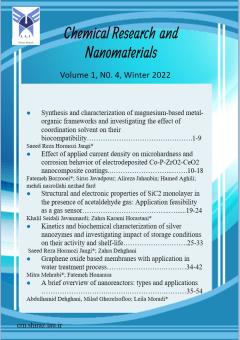Effect of applied current density on microhardness and corrosion behavior of electrodeposited Co-P-ZrO2-CeO2 nanocomposite coatings
Subject Areas : Synthesis and Characterization of Nanostructures
Fatemeh Borzooei
1
![]() ,
Sirus Javadpour
2
,
Alireza Jahanbin
3
,
Hamed Aghili
4
,
mehdi nasrollahi nezhad fard
5
,
Sirus Javadpour
2
,
Alireza Jahanbin
3
,
Hamed Aghili
4
,
mehdi nasrollahi nezhad fard
5
1 - Department of Materials, Faculty of Engineering, Shiraz University, Shiraz,Iran
2 - Department of Materials, Faculty of Engineering, Shiraz University, Shiraz,, Iran
3 - Department of Materials, Faculty of Engineering, Shiraz University, Shiraz,Iran
4 - Department of Materials, Faculty of Engineering, Shiraz University, Shiraz,Iran
5 - Department of Materials, Faculty of Engineering, Shiraz University, Shiraz,Iran
Keywords: Electrochemical deposition, Nanocomposite Coating, Corrosion Resistance, Microhardness, Current Density,
Abstract :
Cobalt coatings are considered a suitable alternative to chromium coatings due to their desirable properties and environmental compatibility. In this study, by adding phosphorus as an alloying element and reinforcing nanoparticles of ZrO2 and CeO2 to the cobalt coating matrix, amorphous Co-P-ZrO2-CeO2 and Co-P coatings were produced on a ST37 steel substrate using electrochemical deposition. The effect of current density on the morphology of the coatings was investigated by scanning electron microscopy (SEM), and the weight percentages of elements present in the coatings were analyzed using EDS analysis. Microhardness and corrosion resistance were also examined. The addition of reinforcing nanoparticles to the cobalt-phosphorus alloy matrix increased the hardness of the nanocomposite coatings. It should be noted that increasing the current density up to an optimal level increases the hardness, and then decreases it. The results of the Tafel and EIS analyses on the nanocomposite coatings indicate an increase in corrosion resistance with an enhancement in current density up to 100 mA/cm2 for both alloy and nanocomposite samples, which is due to an increase in the weight percentage of phosphorus and the formation of a surface protective layer. In addition, the presence of reinforcing nanoparticles in the matrix prevents corrosive medium from reaching the coating surface, improving its corrosion resistance.
[1] A. J. Bard, L. R. Faulkner, E. Swain, and C. Robey, Fundamentals and Applications, 2nd ed. JOHN WILEY & SONS, INC (2001)
[2] V. Ezhilselvi, H. Seenivasan, P. Bera, and C. Anandan, RSC Adv. 4, 46293 (2014)
[3] A. Farzaneh, M. Mohammadi, M. Ehteshamzadeh, and F. Mohammadi, Appl. Surf. Sci., 276, 697 (2013)
[4] G. Yasin, M. Arif, T. Mehtab, M. Shakeel, M. A. Khan, and W. Q. Khan, In Corrosion protection at the nanoscale, (Elsevier Inc., 2020) p.245.
[5] M. Barzegar, S. R. Allahkaram, R. Naderi, and N. Ghavidel, Wear, 422, 35 (2019)
[6] I. Kosta, A. Vicenzo, C. Müller, and M. Sarret, Surf. Coatings Technol., 207, 443 (2012)
[7] M. A. Sheikholeslam, M. H. Enayati, and K. Raeissi, Mater. Lett., 62(21-22), 3629 (2008)
[8] A. Noruziyan Kermani, M. Zandrahimi, H. Ebrahimifar, Advanced Materials and New Coatings, 8(31), 2258 (2020).
[9] Y. Wang, D. Cao, W. Gao, Y. Qiao, Y. Jin, G. Cheng, Z. Zhi, et al., J. Alloys Compd., 792, 617 )2019(
[10] M. Fathi, M. S. Safavi, S. Mahdavi, S. Mirzazadeh, V. Charkhesht, A. Mardanifar, M. Mehdipour, Tribology. Int., 159, 106956 )2021(
[11] M. S. Saman, F. C. Walsh, Surf. Coat. Technol., 422, 127564 )2021(.
[12] M. S. Safavi, M. Fathi, V. Charkhesht, M. Jafarpour, and I. Ahadzadeh, Metall. Mater. Trans. A, 51, 6740 )2020(
[13] J. A. M. Oliveira, A. F. de Almeida, A. R. N. Campos, S. Prasad, J. J. N. Alves, and R. A. C. de Santana, J. Alloys Compd., 853, 157104 )2021(
[14] J. Liang et al., Surf. Eng., vol. 0844, 33(2), 110 )2016(
[15] S. D. Zhaoyang Song, Hongwen Zhang, Xiuqing Fu, Jinran Lin, Moqi Shen, Qingqing Wang, Coatings, 10(7), 616 )2020(
[16] Y. Wang, X. Shu, S. Wei, C. Liu, W. Gao, R. A. Shakoor, R. Kahraman, J. Alloys Compd., 630, 189 )2015(
[17] Z. Zhang and D. L. Chen, Mater. Sci. Eng. A, 483, 148 )2008(
[18] Z. He, D. Cao, F. Cao, S. Zhang, and Y. Wang, Surf. Eng. 36(7), 720 )2020(
[19] B. Li and W. Zhang, J. Alloys Compd., 820, 153158 )2020(
[20] P. Baghery, M. Farzam, A. B. Mousavi, and M. Hosseini, Surf. Coatings Technol., 204(23), 3804 )2010(
[21] S. Mosayebi, M. Rezaei, and Z. Mahidashti, Colloids Surf. A Physicochem. Eng. Asp. 594, 124654 (2020)
[22] N. P. Wasekar, S. M. Latha, D. S. Rao, and G. Sundararajan, Mater. Des. 112, 140 (2016)


